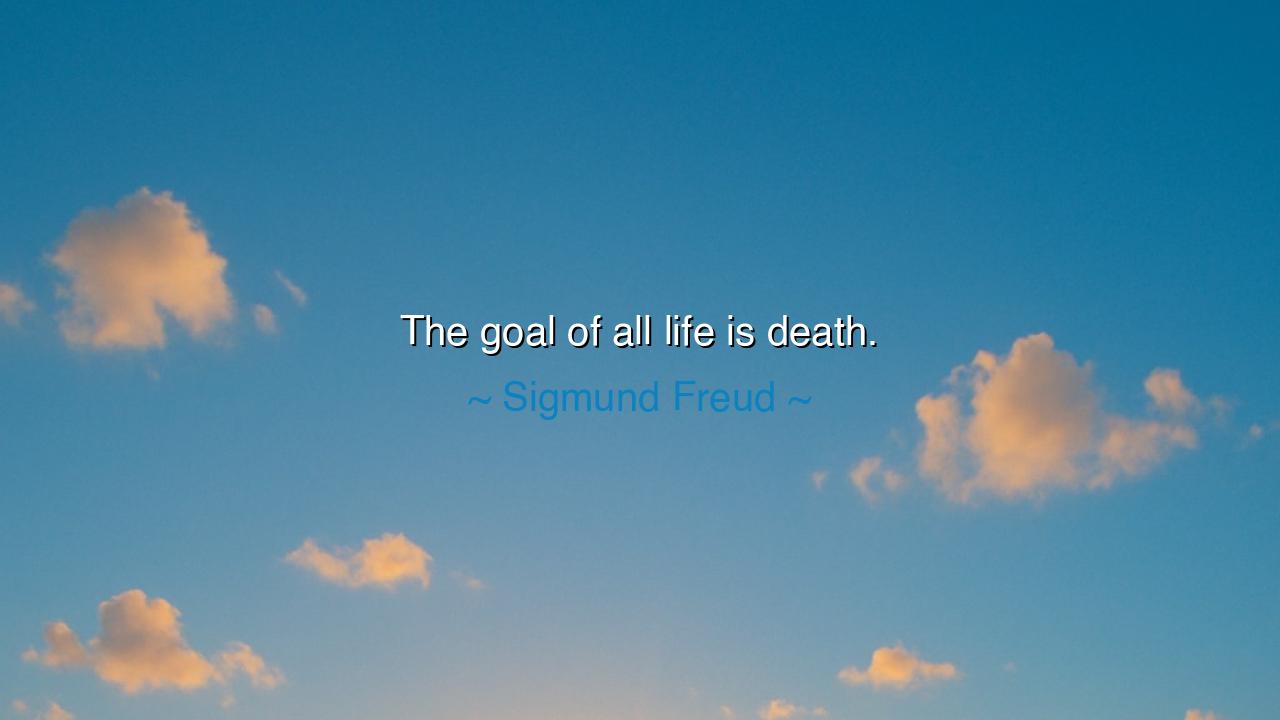
The goal of all life is death.






“The goal of all life is death.” Thus wrote Sigmund Freud, the father of psychoanalysis, whose words pierce like a blade through the illusions of comfort and permanence. To many, these words sound dark — a whisper from the abyss — yet beneath their shadow lies a profound truth about the rhythm of existence. Freud did not speak of death as a doom to be feared, but as the natural end toward which all things move, the still point to which the pulse of life returns. Just as every wave, no matter how high it rises, must fall again into the sea, so every living thing, having spent its force, returns to the silence from which it came. This is not tragedy, but completion, the circle of being drawn to its close by the invisible hand of time.
The origin of this idea comes from Freud’s reflections in his later works, particularly Beyond the Pleasure Principle (1920). There he pondered the strange paradox of human behavior — that even as we seek pleasure, comfort, and survival, we are irresistibly drawn toward self-destruction, decay, and rest. He called this the death drive, or Thanatos, naming it after the ancient Greek god of death. To Freud, every living being carries within itself not only the desire to live (Eros), but also the quiet yearning to return to the peace that preceded birth — a longing for stillness, for the dissolution of tension, for the deep rest that only death can bring. Thus, the goal of all life is not eternal struggle, but eventual release.
This truth is as old as the world itself. The ancients knew it long before Freud gave it a name. In the East, the sages of India taught that life and death are not enemies, but twin gates of the same passage — that every soul seeks to return to the infinite from which it came. The Stoics of Greece and Rome, too, meditated daily on mortality, not in despair, but in peace. They understood that death is the final harmony, the reconciliation of all opposing forces. The flower blooms not to deny death, but to fulfill its purpose — for the seed cannot rise again unless the bloom first fades. So too, man lives not to escape death, but to complete the pattern of existence.
Freud, though a man of science, spoke the language of the philosophers when he wrote these words. He saw death not as an end of meaning, but as the ultimate fulfillment of nature’s law. In every cell and instinct lies a drive toward equilibrium — a desire to end the restless striving of life. The beating heart, the burning mind, the endless yearning of the human soul — all seek rest, and that rest, in its final form, is death. This does not make life meaningless; rather, it gives it depth. For it is because we die that we truly live. The awareness of mortality sharpens the beauty of every breath, every dawn, every moment of love. Death, in its silent majesty, is the backdrop that makes life’s music resound more clearly.
History itself reveals this duality — the dance between creation and destruction. Consider Oppenheimer, the man who unlocked the power of the atom. His work brought both the promise of boundless energy and the shadow of annihilation. In his trembling voice, quoting the Bhagavad Gita, he said, “Now I am become Death, the destroyer of worlds.” Yet even in that moment of dread, one could see the truth of Freud’s vision: that the human drive to create — to reach for the heavens — carries within it the seed of its own undoing. Every civilization that rises must one day fall, and from its ashes, new life begins again. This is not punishment, but renewal, the eternal cycle of Eros and Thanatos, of life yearning for itself and for its rest.
And yet, there is a softer wisdom hidden in Freud’s grim philosophy. If death is the goal, then every moment of life is a step along that sacred road — a journey not of despair, but of understanding. To live with this awareness is to live more consciously, more gratefully. For those who forget death waste their days; but those who remember it learn to cherish them. The man who knows he will die learns to forgive more easily, to love more deeply, to let go of pride and vanity. He does not seek to defy mortality, but to walk toward it with dignity, his eyes open, his soul at peace.
So, my child, take this teaching to heart: do not fear death, but learn from it. It is the great equalizer, the silent teacher of humility and meaning. Live knowing that every sunrise is borrowed, every heartbeat a gift. Let this awareness free you from the small anxieties of life, for nothing that dies was ever meant to last. Instead, live well — live so fully, so fiercely, so compassionately, that when your final hour comes, you may greet it not as an enemy, but as an old friend come to lead you home. For as Freud reminds us, the goal of all life is death — not as a defeat, but as a return to the stillness from which all beauty first was born.






AAdministratorAdministrator
Welcome, honored guests. Please leave a comment, we will respond soon